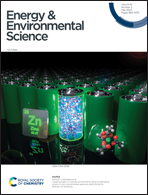Phase transition engineering for effective defect passivation to achieve highly efficient and stable perovskite solar cells†
Abstract
To obtain highly efficient and stable perovskite solar cells (PSCs), defects must be removed at the grain boundaries of the perovskite films. Most surface-treatment methods involve dissolving the passivating material in a solvent and applying it to the surface. However, as the surface-treatment temperature increases, the solvent evaporates, resulting in the reaction occurring in the solid state. In this work, we report an effective interfacial-engineering method for PSCs involving the in situ thermal phase transition of alkylammonium formates (AAFos). AAFos, which consist of a large organic cation with a pseudo-halide anion, can participate in the passivation as the liquid phase at relatively low temperatures because of the weak coordination between the cations and anions. This property accounts for their several benefits in interfacial engineering: (1) by enhancing the liquid-like behavior of AAFo, it can effectively passivate into the grain boundaries of perovskites to reduce the trap densities. (2) The formate anion has a relatively higher affinity with iodide vacancies than other halides, resulting in effective passivation at iodide vacancies for improved thermal stability. (3) The long alkyl chain of decylammonium cations improves moisture stability by preventing moisture permeation into the perovskite layer. Thanks to these advantages, we achieved a power-conversion efficiency (PCE) of 25.0% with superior thermal stability (under N2 at 85 °C) and moisture stability (60 ± 10% of relative humidity), which retained over 92% and 81% of their initial efficiency for 1000 hours using dodecylammonium formate. Finally, we achieved a high efficiency of 20.82% and a remarkable fill factor (80.77%) in PSC modules with an active area of 23.75 cm2, proving the suitability of the strategy for manufacturing large-area devices. This work demonstrates that defect passivation via thermal-phase transition is an efficient strategy for improving the PCE and stability of PSCs.



 Please wait while we load your content...
Please wait while we load your content...